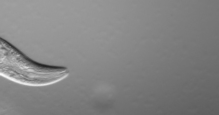Key to 'curing' obesity may lie in worms that destroy their own fat

(PhysOrg.com) -- A previously unknown mutation discovered in a common roundworm holds the promise of new treatments for obesity in humans, McGill University researchers say. Their study was published Dec. 3 in the journal Nature, and was funded by the Canadian Cancer Society and the Canadian Institutes of Health Research.
In lean times, a normal Caenorhabditis elegans worm goes into a form of suspended animation called "dauer" that slows its metabolism and allows it to survive for extended periods without food.
"When they go into dauer, these worms radically alter their metabolism," said Dr. Richard Roy, a cancer researcher at McGill's Department of Biology specializing in the control of cell division. "They shut down everything energy-consuming, which includes foraging, cell division and reproduction."
Unlike other "hibernating" organisms, C. elegans maintains a degree of mobility during dauer by stocking up on energy in the form of fats – or lipids – which they store in special cells or reserves.
"This allows them to live up to six months without eating, instead of the two weeks they would otherwise have," Roy explained. A worm with the newly discovered mutation, however, will usually die within a week of going into dauer
"These mutants somehow cannot shut down the process of cell division, which is why we noticed them in the first place," Roy said. "However, that's not what kills them. They cannot adjust their metabolism correctly. They store up their six-month lipid reserves, but as soon as they shift into dauer they use them up within a few days. This is because they lack an enzyme that blocks the activity of a very important triglyceride lipase. Without this regulation the lipase burns up all the fat it encounters and destroys the worm's energy reserves."
This discovery was a near-accidental by-product of Roy's regular line of research, searching for cells that abnormally disobey cellular signals in a cancer context, and he gives graduate student and study first author Patrick Narbonne much of the credit.
"Patrick was absolutely brilliant. He was so observant that he noticed these animals were dying way too early, and he also realized that they were not dying because of the cell-division issue."
Roy and Narbonne believe this discovery, which will require considerable additional research, may have significant long-term implications for human health.
"I think we should start looking at the enzymes involved in this cascade, particularly in obese individuals. They are likewise accumulating lipids, but in a reverse situation to C. elegans, this enzyme isn't recognizing it, or something is blocking its function. We're making the case that we can uncouple this enzyme from its normal regulation. If we could develop drugs to do that selectively in fatty tissue, we'd be able to chew up all the fat."
"This study fascinates me," said Dr. Robert Sladek, one of Canada's most prominent diabetes researchers, affiliated to the McGill Department of Human Genetics and the McGill and Genome Quebec Innovation Centre. "It will be exciting to see whether this pathway that controls energy storage and lifespan in worms plays a similar role in humans. The implications for patients with obesity and diabetes might be quite far-reaching."
Provided by McGill University



















